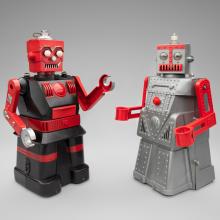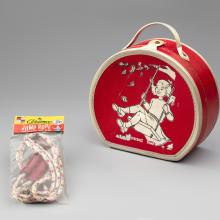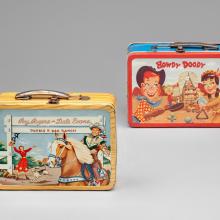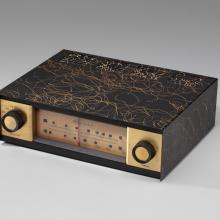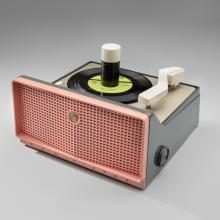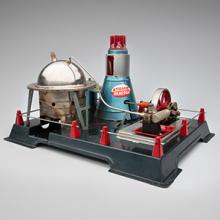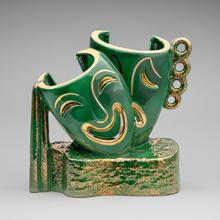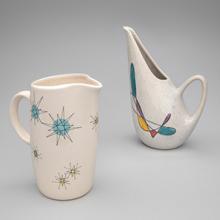Terminal 3












Robot and Son 1956
Louis Marx and Company
New York
Courtesy of Mickey McGowan
Unknown Museum Archives, San Rafael, California
L2018.2515.011a–b
Robert the Robot 1955
Ideal Toy Corporation
Hollis, New York
Courtesy of Mickey McGowan
Unknown Museum Archives, San Rafael, California
L2018.2515.012a
Robots are the most iconic, space-themed toys. Japanese manufacturers pioneered the robot toy craze in the late 1940s with Atomic Robot Man, a wind-up, tin lithograph toy that walked on its own. Robert the Robot was the first plastic toy robot manufactured in the United States. Made from Alathon, a molded, thermoplastic developed by the DuPont Company, Robert the Robot was mechanically operated by a driveshaft cable and remote control. A small, windup record player hidden inside the toy enabled Robert to repeat the phrase, “I am Robert the Robot, the mechanical man, drive me, steer me, wherever you can."
Jump Rope c. 1950s
Gramco
Lowell, Massachusetts
Courtesy of Mickey McGowan
Unknown Museum Archives, San Rafael, California
L2018.2515.026
Swing Time purse c. 1950s
maker unidentified
Courtesy of Mickey McGowan
Unknown Museum Archives, San Rafael, California
L2018.2515.025
A distinctly modern, consumer-based American youth culture emerged during the 1950s. On average, middle-class adolescents earned more in allowance per week than many families took in during the Great Depression, and young people became consumers for the first time. Toys and other products were marketed specifically to girls and boys, and kids personalized their rooms with a variety of items. Hula hoops, jump ropes, plastic purses, chewing-gum wrapper chains, and other fads abounded.
Ford Skyliner 1958
Kosuge
Japan
Collection of SFO Museum
1997.25.01.01–.02
L2018.2501.009.01–.02
America’s fascination with the automobile reached new heights during the postwar years. From 1945–55, the number of cars on American roads doubled, and throughout the 1950s, dealers sold more than seven million cars and trucks every year. Automobile toys made from die-cast steel, molded plastic, and printed tin mirrored their full-sized counterparts. Japanese and German toy makers engineered some of the more advanced toys. These tin lithograph cars featured friction or electric motors, and battery-operated accessories including working lights and convertible tops.
Roy Rogers and Dale Evans lunch box 1954 | Howdy Doody lunch box 1954 |
Television introduced a series of western-themed shows that delighted children all over America. Dolls, lunchboxes, and other toys accompanied The Howdy Doody Show (1947–60), one of the era’s most successful children’s shows. Created and hosted by “Buffalo Bob” Smith (1917–98), the iconic, marionette theater program provided a blueprint for children’s television programming. Four years later, The Roy Rogers Show (1951–57) premiered on NBC, starring the actor-musician and “King of the Cowboys,” Roy Rogers (1911–98). Set in the fictional town of Mineral City, the show featured Rogers, his golden palomino Trigger, and the theme-song “Happy Trails,” a duet performed alongside Rogers’ wife and co-star, Dale Evans (1912–2001).
Model HF–255 tuner 1956
Rauland-Borg Corporation
Chicago
Courtesy of John Eckland
L2018.2510.014
During the late 1940s, high-fidelity audio equipment progressed from floor standing, cabinet radios to scientifically designed, component-based systems. By the 1950s, most arrangements included a multi-channel pre-amplifier with volume and tone controls; a high power, low-distortion amplifier; a dynamically balanced, constant-speed turntable; and a Superheterodyne AM-FM tuner. A number of technological improvements made true, high-fidelity sound possible. Reel-to-reel, multi-track studio equipment created recordings that were more complex and lifelike. A handful of radio stations operating on FM, or frequency modulation, broadcast musical programming without the pops and noise associated with AM radio.
Model 8-PT-7034 Personal 1956
Radio Corporation of America, RCA Victor Television Division
Camden, New Jersey
Courtesy of John Eckland
L2018.2510.002
Television quickly surpassed radio as the most popular media in the United States during the 1950s. At the beginning of the decade, approximately one in ten households owned a television. By 1960, at least one TV set was installed in nearly ninety percent of American homes. Portable TV sets brought television to a wider audience. Compact and more affordable than heavier, full-size models, portable televisions could be transported to various rooms of the home with relative ease. In the mid-1950s, personal portable sets incorporated miniature tubes and became even smaller—however, they still required household voltage to operate.
Model 7–EY–1JF 1955
Radio Corporation of America, RCA Victor Division
Camden, New Jersey
Collection of California Historical Radio Society, Alameda, California
L2018.2505.002
By the mid-1950s, record companies released the majority of rhythm-and-blues and rock ‘n’ roll songs as 45-rpm singles. To promote record sales, RCA Victor introduced an affordable line of 45-rpm record players. Marketed towards teenagers and young adults, these portable devices allowed for the playback of popular records in bedrooms and away from the living room, out of earshot from prying parents. The extended-play 45, or EP, was released in 1951. EPs featured slanted record grooves as opposed to the vertical grooves in a standard 45, allowing for almost 8 minutes of playing time, or two normal-length pop songs, per side.
Tahoe Tropicana postcard c. 1950s–60s | Lake Tahoe South Shore ice bucket c. 1950s–60s |
During the mid-20th century, Americans took to the road in an unprecedented boom in auto tourism. By 1964, more than 61,000 roadside motor hotels, commonly known as motels, had appeared alongside America’s highways and byways. Simply constructed and marked by eye-catching neon signage, motels reflected regional themes, modern architecture, and kitschy design. Lake Tahoe became a favorite vacation destination in the late 1940s. Attracted to year-round activities such as snow-skiing in the winter and boating during summer months, tourists also found casino entertainment in South Lake Tahoe, and in 1960, Lake Tahoe hosted the Winter Olympics.
Model 80 Land Camera 1957–59 | Model 95B Land Camera 1957–61 |
While on vacation in 1944, Edwin Land (1909–91) took a picture of his three-year-old daughter, who promptly asked to see the photo. This technology did not yet exist, and four years later, Land introduced the first commercially viable instant camera—the Polaroid Model 95. Advertised as the “Picture-in-a-Minute” camera, this revolutionary device combined film exposure and processing into one unit. In addition to subsequent models of Polaroid cameras, Land invented a range of products based on the polarizing properties of light including desk lamps, sunglasses, 3-D movie equipment, and even the camera on the U-2 spy plane.
Atomic Reactor steam toy c. 1950s
Linemar
Japan
Courtesy of Mickey McGowan
Unknown Museum Archives, San Rafael, California
L2018.2515.076
The atomic age permeated American culture throughout the 1950s and into the 1960s, influencing literature, film, television, and consumer goods. Anxiety surrounding atomic testing and fallout became more prevalent, and as tensions rose between the United States and the Soviet Union, the threat of nuclear war loomed in the public mind. To counteract widespread fear, atomic energy was promoted as a safe and efficient source of power. Families set aside rations and constructed fallout shelters, and by the end of the decade the first nuclear power plants began service.
Comedy-Tragedy TV lamp c. 1950s
Hedi Schoop (1906–95)
Hedi Schoop Art Creations
Hollywood, California
Courtesy of Matt Householder and Candi Strecker
L2018.2512.007
TV lamps were designed to preserve one’s eyesight while watching television in the dark. While this idea may sound strange today, the picture quality of early sets was somewhat dim, causing people to watch programming in darkened rooms to improve the viewing experience. Fears surfaced concerning the potential for eyesight damage, and some even believed that prolonged exposure could cause blindness. TV lamps flooded the shelves of department and dime stores. Commonly produced as back-lighted figural forms, these kitschy, ceramic lamps were proudly displayed atop televisions and provided an eerie, dim glow that allowed for hours of guilt-free television viewing. Ceramics manufacturers created thousands of designs in the form of panthers, geese, fish, cats, and other animals.
Franciscan Atomic Starburst pitcher c. 1950s–60s
George James (1921–2003)
Gladding, McBean and Company
Glendale, California
Courtesy of Jeff and Stacy Keller
L2018.2513.010
Poppytrail California Mobile pitcher c. 1950s–60s
Frank Irwin (1922–2002)
Metlox Manufacturing Company
Manhattan Beach, California
Courtesy of Jeff and Stacy Keller
L2018.2513.018
Modern entertaining called for contemporary and expressive dinnerware. In 1954, two California-based manufacturers introduced a selection of progressive earthenware lines. The quintessentially modern Starburst design was a transfer-printed pattern created by Mary C.L. Brown (1913–65) to decorate George James’ (1921–2003) futuristic line of Eclipse dinnerware for Franciscan. Around the same time, Metlox added the California Mobile series to their Poppytrail earthenware. Designed by Frank Irwin (1922–2002), California Mobile was a decal pattern applied to Metlox’ Freeform range of sculpturally squared plates and boomerang-shaped dishes.
